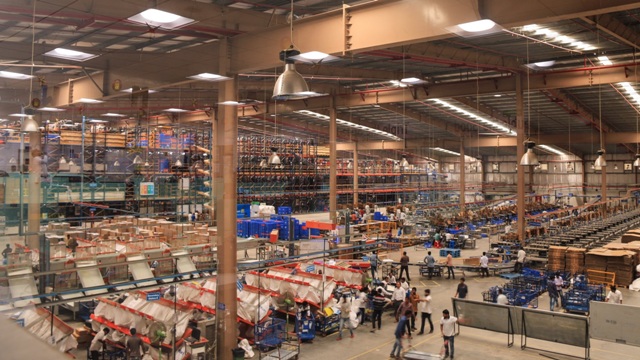by Vimal Nadar, Senior Director & Head, Research, Colliers India
Despite challenges like regulatory complexities and infrastructural deficiencies, collaborative efforts aimed at skill development, technology integration, and sustainable practices can position the warehousing sector as a key driver of India's economic growth
Over the past few years, India has witnessed a consistent surge in industrial and warehousing activities, fueled by the rise in demand from 3PL and E-commerce players, increasing manufacturing output, expanding institutionalization and a burgeoning consumer base. The sector has undergone significant transformation, embracing cutting-edge technologies, optimizing supply chain operations, and redefining traditional logistics paradigm. On the supply front, industrial and warehousing units across the country are adapting to meet the diverse needs of modern businesses, from state-of-the-art fulfilment centers to temperature-controlled storage facilities.
In 2023, India's industrial and warehousing sector witnessed resilient demand, reflecting a steady growth in Grade A space uptake. As per Colliers, the sector recorded 25 mn sq ft of gross leasing in 2023 across five major cities of the country, a 2 percent annual growth. This growth, especially prominent in the latter half of the year, underscored the sector's adaptability in the face of evolving market dynamics. During the year, Pune led the demand with a 25 percent share, closely followed by Mumbai at 22 percent. Interestingly, Chennai saw industrial & warehousing leasing demand almost at par with Delhi NCR, the usual frontrunner, with more than 5 mn sq ft of gross absorption during the year.
- Unlocking opportunities in India's warehousing sector
The warehousing sector in India presents a myriad of opportunities propelled by evolving market dynamics, technological advancements, and favorable policy interventions. Amidst rapid evolution and innovation, the Indian government's initiatives like ‘Make in India’ and the Production Linked Incentive (PLI) schemes are fostering industrial growth and attracting investments in the warehousing sector. Additionally, recent announcements made during the interim budget for FY 2024-25, including an 11.1% YoY increase in infrastructure outlay to INR 11.1 lakh crore, and the implementation of three major economic railway corridor programs under PM Gati Shakti, will further enhance transportation networks and streamline logistics-based operations.
-
Growing demand for modern and tech efficient warehouses
There is a growing demand for modern warehousing facilities equipped with automation, robotics, and IoT solutions to meet the evolving needs of consumers. By investing in specialized warehousing facilities tailored to the unique requirements of the industries, warehousing providers can unlock new avenues for growth and differentiation. -
Focus on green warehouses
Additionally, the integration of sustainable practices presents a compelling opportunity for warehouse providers to adopt sustainable solutions such as renewable energy sources and eco-friendly packaging materials, thereby enhancing operational efficiency while contributing to environmental conservation efforts. -
Transition towards Electric Vehicles (EVs)
The growth of the EVs creates opportunities for real estate stakeholders from manufacturing to charging infrastructure. The transition towards EV in the automotive sector fuels demand for battery storage and assembly facilities. Over the next three to five years, India is likely to see total investments of INR 94,000 crore (USD12.6 billion) in the EV space. -
Rising demand for cold-storage and life sciences facilities
The proliferation of cold chain logistics offers significant potential for specialized warehousing solutions, particularly in segments like perishable commodities and pharmaceuticals, where there is a rising demand for temperature-controlled storage and transportation facilities. Investing in cold chain infrastructure enables warehousing companies to diversify their service offerings and cater to niche markets effectively. Moreover, new age industries like life sciences also present untapped opportunities as they require stringent storage and handling protocols for pharmaceuticals and medical devices. -
Growth of Q-commerce in India
Leveraging on advanced logistics infrastructure and innovative delivery solutions, Q-commerce players aim to streamline the shopping experience, offering customers the convenience of ordering essential items with minimal wait time. As the Indian market continues to embrace digitalization and online shopping, Q-commerce is poised to play a pivotal role in shaping the future of retail, providing consumers with unparalleled convenience and accessibility to a wide range of products across bigger and smaller cities.
Challenges in India's warehousing sector
Despite its immense growth potential, the warehousing sector in India faces several challenges that hinder its full realization of opportunities and potential.
- Complexities in regulatory framework are characterized by a fragmented regulatory landscape and inconsistent enforcement practices across different states and regions. Navigating through diverse regulations related to land acquisition, construction permits, environmental clearances, and labor laws often poses obstacles in timely project execution and investment inflows. Harmonizing regulatory frameworks and streamlining approval processes are essential in fostering a conducive business environment and attracting investments in the warehousing sector.
- Unavailability of large contiguous and compliant land parcels in urban and peri-urban areasleads to restricted expansion opportunities and hinders growth. At the same time, it leads to exorbitant land prices which impacts overall project costs.
- Inadequate infrastructure particularly in Tier-II and Tier-III cities, restricts market access and distribution reach, necessitating focused investments in logistic parks and last-mile connectivity. A shortage of skilled labor further exacerbates the situation in these smaller cities.
- Absence of standardized quality and safety norms poses risks to cargo and personnel safety, necessitating stringent protocols and employee training. Emerging risks such as geopolitical tensions, trade disruptions, and natural disasters, further aggravatesthe challenges faced by the warehousing sector.
Building resilience through proactive risk management strategies, contingency planning, and diversification of supply chain networks can help mitigate the impact of unforeseen events and enhance the sector's ability to adapt to changing market conditions.






